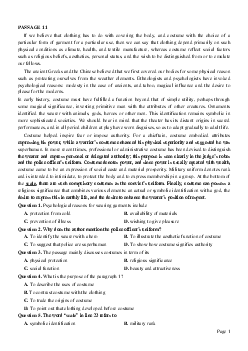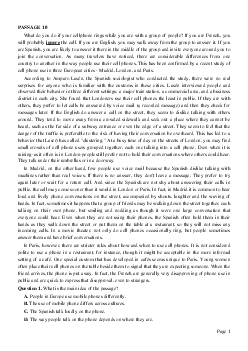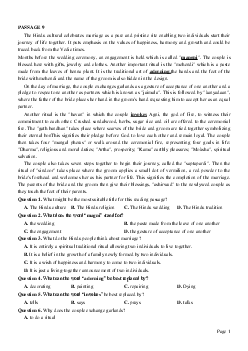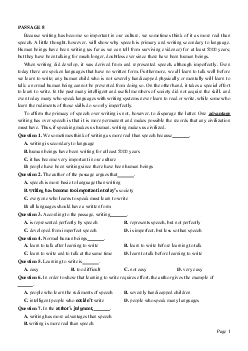


Preview text:
PASSAGE 33
There is a scam aimed at a child’s desire to be a published writer – usually as a poet, in a book of poems. How does the s cam work?
Keen teachers are unwittingly caught up in the promotion but are completely unaware of the dodgy side of the scheme.
There are plenty of honest opportunities for children’s writing that don’t cost their parents a small fortune
and provide a poor-quality product. Most books in scams are badly set out. They tend to be huge volumes,
squashing in as many writers’ efforts as possible to make as much money as possible. They’re an
embarrassment for the young poets.
These competitions to ‘discover hidden talent’ sound great in the glossy flyers. Schools too are offered a
prize if a winner is from their school. Schools become unpaid ‘agents’ in promotion of the competitions.
Parents are happy to pay a small entry fee.
Each child hopes to get an ‘honourable mention’ with the possibility of being selected to be included in a
book. The price of the book is not given. Naturally, if a child’s work were published, parents would want
a copy of the book. In one such scheme the pre-order price was $67 with an extra $26 if the child’s photo
was included. That’s nearly $100! Strangely, awards are given to those who pre-order a book!
The books are not attractive. A copy at a market sold for $2. There were three to five kids’ poems
squashed on a page, with over 3000 poems jammed into that one book. Clip Art was used to illustrate the
poor publication. Look at the maths. 3000 kids multiplied by $100 equals $300,000. Now add the entry
fees of, say. $2 – add another $6000! Enough to cover publicity! One ‘place winner’ was upset when the
parents realized this was a con to buy a book, but not buying the book made the parents feel guilty.
Genuine competitions that publish books give a free copy to any ‘winner’.
Question 1. According to the passage, a scam is .
A. a scheme for making money dishonestly
B. a technique to provide teachers with learning incentives
C. an opportunity for publishers to reach a larger market
D. a means of letting children see their name in print
Question 2. Parents are likely to buy a copy of a book that includes their child’s work because .
A. they want the anthology to be a financial success
B. the anthology is value for money
C. they are proud of their child’s ‘success’
D. it confirms their belief in their child
Question 3. Books of verse written by children are popular promotions because .
A. most parents enjoy children’s poetry
B. teachers encourage poetry writing in schools
C. children write better poetry than prose
D. children’s schools and parents get benefits from them
Question 4. The mathematics included in the article is intended to .
A. demonstrate the standards the promoters are committed to Page 1
B. explain why the pre-ordering option is important
C. expose the sneaky nature of the scam
D. convince parents to trust the organizers
Question 5. The writer of the article finds the scheme . A. is of great worth
B. causes family unhappiness
C. is difficult to participate in D. is badly organized ĐÁP ÁN 1-A 2-C 3-D 4-C 5-B
LỜI GIẢI CHI TIẾT Question 1: A
Theo đoạn văn, một trò lừa đảo là .
A. một kế hoạch kiếm tiền không trung thực
B. một kỹ thuật để cung cấp cho giáo viên khuyến khích học tập
C. một cơ hội cho các nhà xuất bản tiếp cận một thị trường lớn hơn.
D. một phương tiện cho phép trẻ em nhìn thấy tên của chúng in
DẪN CHỨNG: There are plenty of honest opportunities for children’s writing that don’t cost their
parents a small fortune and provide a poor-quality product. Most books in scams are badly set out. They
tend to be huge volumes, squashing in as many writers’ efforts as possible to make as much money as possible.
DỊCH: Có rất nhiều cơ hội trung thực cho trẻ em bằng văn bản mà don don đã trả cho cha mẹ chúng một
gia tài nhỏ và cung cấp một sản phẩm chất lượng kém. Hầu hết các cuốn sách về lừa đảo được đặt ra xấu.
Họ có xu hướng là khối lượng lớn, tập trung vào càng nhiều nhà văn nỗ lực càng nhiều càng tốt để kiếm
được càng nhiều tiền càng tốt. Question 2: C
Phụ huynh có khả năng mua một bản sao của một cuốn sách bao gồm công việc con của họ vì .
A. họ muốn tuyển tập thành công về tài chính
B. tuyển tập là giá trị đồng tiền
C. họ tự hào về sự thành công của những đứa con
D. nó xác nhận niềm tin của họ vào con của họ
DẪN CHỨNG: These competitions to ‘discover hidden talent’ sound great in the glossy flyers. Schools
too are offered a prize if a winner is from their school. Schools become unpaid ‘agents’ in promotion of
the competitions. Parents are happy to pay a small entry fee.
DỊCH: Những cuộc thi để ‘khám phá tài năng tiềm ẩn âm thanh tuyệt vời trong những tờ quảng cáo bóng
loáng. Các trường cũng được cung cấp một giải thưởng nếu một người chiến thắng đến từ trường của họ.
Các trường trở thành không được trả lương ‘đại lý quảng bá các cuộc thi. Phụ huynh rất vui khi trả một
khoản phí nhập cảnh nhỏ. Page 2 Question 3: D
Sách thơ được viết bởi trẻ em là chương trình khuyến mãi phổ biến vì .
A. hầu hết các bậc cha mẹ đều thích thơ trẻ con
B. giáo viên khuyến khích viết thơ trong trường học
C. trẻ viết thơ hay hơn văn xuôi
D. trẻ em trường học và phụ huynh nhận được lợi ích từ họ
DẪN CHỨNG: There are plenty of honest opportunities for children’s writing that don’t cost their parents a small fortune.
DỊCH: Có rất nhiều cơ hội trung thực cho trẻ em bằng văn bản mà không mất phí đã trả cho cha mẹ chúng một gia tài nhỏ. Question 4: C
Các toán học bao gồm trong bài viết được dự định để .
A. thể hiện các tiêu chuẩn mà các nhà quảng bá cam kết
B. giải thích tại sao tùy chọn đặt hàng trước là quan trọng
C. vạch trần bản chất lén lút của lừa đảo
D. thuyết phục phụ huynh tin tưởng ban tổ chức
DẪN CHỨNG: Look at the maths. 3000 kids multiplied by 100 equals 300,000. Now add the entry fees
of, say. 2–addanother 6000! Enough to cover publicity!
DỊCH: Nhìn vào toán học. 3000 trẻ nhân với 100 đô la tương đương với 300.000 đô la. Bây giờ thêm phí
nhập cảnh của, nói. 2−thêm 6000! Đủ để che đậy công khai! Question 5: B
Người viết bài báo tìm thấy âm mưu . A. có giá trị lớn
B. gây ra bất hạnh gia đình C. khó tham gia D. bị tổ chức kém
DẪN CHỨNG: One ‘place winner’ was upset when the parents realized this was a con to buy a book, but
not buying the book made the parents feel guilty.
DỊCH: Một người chiến thắng tại chỗ đã buồn bã khi cha mẹ nhận ra đây là một kẻ lừa đảo để mua một
cuốn sách, nhưng không mua cuốn sách khiến cha mẹ cảm thấy có lỗi. Page 3




